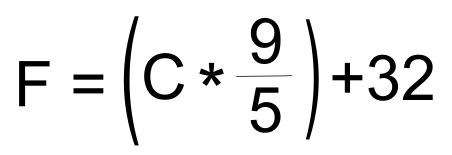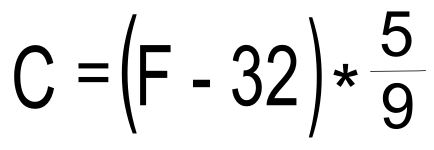Temperature Conversions
Celsius and Fahrenheit
Much like how we've held off on converting to the Metric system in the U.S., we still use the Fahrenheit scale often to measure temperature. In Chemistry, however, Celsius is more often used because of its better accuracy for determining chemical reactions. Sometimes referred to as centigrade, the Celsius scale is shaped primarily around the temperature water freezes and boils in lower altitudes.
|
Formulas to convert between C° and F° :

Algebra Function #1
This is the easiest one to memorize. If you're comfortable with basic algebra, this is all you'll ever need. On the fly, you just plug in a value for C° or F°, and work a few lines of math to find the conversion's equal. If you haven't got a grip on algebra yet, you could still learn how to do this pretty easily. This equation is the same as what's taught in pharmacy math.
Click here to see how to use this equation (F = 1.8C + 32)

Algebra Function #2
This is the second easiest one to memorize. Just like the one above, you just have to plug in a value for C° or F°, and work a few lines of math to find the conversion. For some people this function seems more straight-forward. It's the same exact equation as above, but multiplied by 5 to avoid dealing with a decimal.
Click here to see how to use this equation (5F = 9C + 160).

Standard Format : F° to C°
This is the same as the ones above, but a bit more basic math friendly. As you've probably noticed, since Fahrenheit temperatures (above freezing) are always larger than Celsius, I prefer to always have F on the left side of the equation. It keeps things straightforward by not creating negative numbers to work through.

Standard Format : C° to F°
Again, This is the same as the other equations, but with the factors in different spots. You can use ANY of the above formulas and get the same exact results. The bottom two are what you'll normally find in a book or pharmacy tech classes.
Q. Why is it necessary to learn this?
A. The ability to convert between C° and F° will come in very handy when you run into test questions involving temperature. After that, you'll occasionally run into product storage requirements that you'll need to decide where to put, etc.
Where would you like to go now?